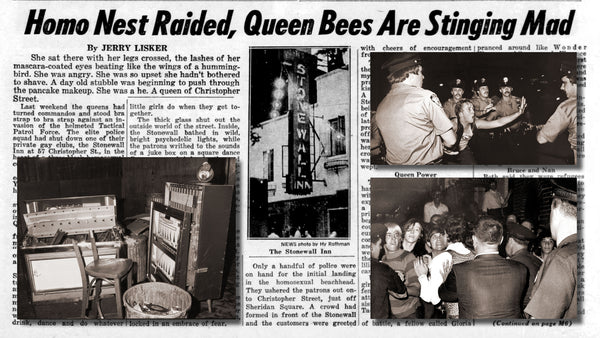On June 28, 1969, a massive riot took place in New York City… perhaps you've heard about it. Unlike the riots/protests/upheaval that dominated the American landscape the year before in 1968, this riot was a turning point of liberation. But liberation from what? Here's the part of the story you don't know.
In 1966, a young Genovese mafia family member named
Tony Lauria ("Fat Tony" - I kid you not) was able to purchased the Stonewall Inn,
then a low-earning bar and restaurant, thanks to the backing of
Matthew “Matty the Horse” Ianiello. With minimal renovations (he painted the walls black) he opened it up as a gay bar in March of 1967 looking as it did in the picture above, taken in 1969.
The Genovese mafia family is the oldest major crime family in the United States, originating with Giuseppe “Clutch Hand” Morello (1867-1930) born in Corleone, Sicily. Morello was running from a murder charge when he came to America around 1892, settling in New York in 1897. Soon after, his half brothers (last name Terranova) made their way to New York as well, the band of them creating a strong united bond making them the first of the “Five Families” of New York crime organizations.
The current name of the family is named after Vito Genovese (1897-1969) who came to the United States in 1912 and lived in Queens, New York and took over the organization as boss from 1957 to 1969. It was under Genovese where the story of a mafia family crosses with the LGBTQ+ history we know as “Pride.”
So much of LGBT history is influenced by the mafia. The term “Friend of Dorothy” can either come from Dorothy Parker OR New York socialite Dorothy Arnold - both known for their gay friends, the latter sometimes being a front for gay men who lived in Greenwich Village and who disappeared under questionable circumstances. The mafia is notoriously terse about many things, but they are especially reticent regarding gay history. And there is a pretty dramatic reason why.
Under Vito, the Genovese crime family controlled the majority of gay bars in Greenwich Village by the mid-1960s and it was a simple, inexpensive, yet lucrative business thanks to watered-down alcohol, no running water, and control over everything from the jukebox to cigarettes. However, the family made more money by blackmailing and extorting some of the more wealthy gay patrons. Fat Tony’s purchase of the Stonewall Inn in 1966 was an unremarkable investment - one of a long line of profitable revenue streams.
Even though being homosexual was legal in the state of New York, establishments serving alcohol to gay customers were considered "disorderly" and were refused liquor licenses by the State Liquor Authority. The solution was to open a bar as a "private bottle club" which didn't require a liquor license... and bribe the police. In the case of the Stonewall Inn, Fat Tony paid New York's Sixth Police Precinct around $1,200 a month.
Seymour Pine (1919-2010) was a long-time New Yorker born in Manhattan and graduating from Brooklyn College in 1941. He was a policeman who joined the Army, and upon returning from war, he went back to being a cop and rose to Deputy Inspector. Pine had already raided the Stonewall 4 days prior. Within that time, 5 other gay bars in the Village had been raided, three of them shut down permanently. The Genovese family didn't care. They kept the liquor stored in the walls of a building or in a parked car allowing them to endure a raid and yet be up and running with little loss the very next day.
But the patrons cared. They were tired of taking the blunt end of disputes between the mafia and the police.
So in the early morning hours of June 28, 1969, when the police raided the Stonewall Inn, the people - let's face it... most of whom were drunk - had had enough and did not go quietly. Once everyone was outside, they became loud and obnoxious, neighbors were woken up, people came out of their homes and from nearby bars to see what was going on. The crowds grew and started throwing coins, trash, bottles, and bricks. A paddy wagon was toppled. The police were caught between a Stonewall and a mob's space. They had no choice but to retreat into the very bar they just raided and barricade the doors. A parking meter was taken out of the curb and used to smash in the door. The boarded windows where broken through. Trash was thrown in and set on fire.
Or, according to the book "Stonewall: The Riots That Sparked the Gay Revolution," page 160:

One policewoman made it out the back through a window (among the terrible conditions of the bar, Stonewall also lacked a rear exit) and went to get help. Eventually, firefighters and a phalanx of police in riot gear arrived to rescue the trapped officers. Skirmishes between the police and the residents went on for the next week.
After the riots, the Genovese mafia family never really recovered from their situation… Fat Tony relinquished ownership of the bar, and the Genovese family closed it for good within months.
DEPENDING ON WHO YOU TALK TO in the mafia, the Stonewall riot is either a really sore subject OR water under the bridge. The riots broke a dam and gave the LGBT community an opening for freedom from mafia manipulation and police brutality. Up until 1969, no one else could open a competing gay bar because to do so would be going up against the Genovese family, and the mafia was the only people who could weather police raids and brutality. Going through the 1970s, the family tried to profit from the Christopher Street Liberation Day Committee and the Christopher Street Festival Committee who ran New York City's gay pride parade in the 1970s and 1980s without much long-term success. Many activists fighting against the reinstallation of mafia control were murdered or died under suspicious circumstances, including activists like Marsha P. Johnson, whose death still remains unsolved.
The Stonewall Riot is an important addition to the long story of emancipation from systemic oppression. "Stonewall = Fight Back" banners were seen across the country at colleges and across the pond in major European cities. It was a fulmination brewing ever since the first mafia man walked into a gay bar and purchased a quiet underground community with really loud claws reaching around the world. Being caught between the mafia and the police was imprisonment. Perhaps for the first time in many of their lives, they gave themselves permission to express their frustration with everything.
It was their liberation.
It’s easy to get sidetracked with PRIDE festivities, the flag-waving, parades, and the ephemeral corporate sponsorship that magically disappears on July 1st... but the lesson we should take away is that the oldest mafia family in America and the New York Police Department went up against the LGBT community… and both the mafia and the police lost.
Officer Seymour Pine was an incredible human being, and every aspect of his life deserves to be documented, from his time in Brooklyn to his World War II service in North Africa and Europe, to his time as Inspector Deputy in New York. It is his time after the Stonewall Riots that really solidifies what an extraordinary man he was. You can see an interview with him HERE. About halfway through he describes the various different ways the mafia was breaking the law including watering down liquor which was a federal offense.
POST SCRIPT FUN FACT:
The Genovese mafia have a long history of not being homophobic. As this story demonstrates, not being homophobic and being an LGBTQ+ ally are NOT the same thing.
In the 1910s until the 1930s, "Little Davey" Petillo (1908-1983) was one of the deadliest assassins in the Genovese family (Luciano crime family at the time). Petillo was a short man (5'-6" or 5'-9" in heels) recruited from the streets early on worked with Lucky Luciano and was a body guard for Al Capone in Chicago for a while. Petillo worked alongside Charles "Chalutz" Gagliodotto (1908-1968), also a short man (5'-0" or 5'-3" in heels).
Both men were cross-dressers, wearing women's clothes to get close to their victims. If you've ever seen or heard of the gangster troupe of a woman dressed in all black, face covered in a veil, at a funeral that turns out to be an assassin for one of the mourners... it is based on Petillo and Gagliodotto who did exactly that. Together they were known as the 'Drag Queen Killers.'
New York wouldn't seen another drag queen this ruthless until Parsons School of Design alum, Dorian Corey. For LGBTQIA+ resources, check out the bottom of this linked blog post.
















Leave a comment